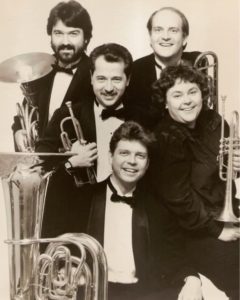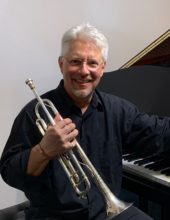BRASS – ensemble
Brass Trio:
Lowly Brass March (9/3/13) for horn, trombone and tuba – 3’30”. This comic, light-hearted work may be performed as either a chamber piece for three players or as an ensemble piece with multiple players on each part. There are opportunities for each instrument to shine. MIDI recording.
Brass Quartet:
St. Patricks’s Day (11/10/15) for trumpet, horn and tuba or trombone – 7’15”. On St. Patrick’s Day, everyone is Irish, or so the Irish would have you believe. MIDI recording.
American Salute (3/2/18) for two trumpets, trombone, and tuba – 8’30”. The work is in three movements. “Fanfare and Flourishes,” “A House Divided,” and “Only the Strong.” MIDI recording.
Brass Quintet:
Brass Farthings (1996) for 2 trumpets, French horn, trombone and tuba – 7’15”.
Live recording. Matrix Brass premiered Brass Farthings in 1996 in New Bern, North Carolina.

Matrix Brass
Brass Sextet:
Semper Fi (2014) for 2 trumpets, horn, trombone, euphonium and tuba. I have always admired the courage and conviction of the Marine Corps. Their loyalty to one another and to the corps creates a comradery that is powerful and patriotic. The three movements of this work represent different aspects of the life of a marine. MIDI recording.
Tuba Quartet:
“Thanks for Stopping By” (2009) for tuba quartet – 3’15”. The work is laidback and jazzy, the kind of farewell one might offer a friend for participating in a pleasant evening. MIDI recording.
Brass with Mixed Ensembles:
Somber Saturdays (5/14/18) for trumpet, bass clarinet and piano – 8’00”. This work was started on May 25, 2013, in aversion using alto flute rather than trumpet. It was the morning of my mother’s memorial service. She was 101. MIDI recording.
Obstination (1/15/16) for flute, horn, violin, cello, and piano – 10’00”. I made up the term “obstination” to refer to a state of pointed and fully intentional obstinacy. I use this term knowing that obstinacy already covers this meaning, but I am too stubborn to use it. Conflict and dramatic tension result from “obstination,” even if compromise is in everyone’s best interest. This work follows such a conflict. MIDI recording.
Blue/Rambliu’/Bear for trumpet/flugelhorn/piccolo trumpet, cello and piano (1989) – 9’10”. The title is in three parts. Blue is both a color reference and a cool feeling because of the coolness of water and of ice. Here, however, there is also an unsettled, mysterious feeling at work. Ramblin’ is a short set of variations on a folksong, “Ramblin’ Gambler.” Bear is so-named, in part, because it is difficult to play, especially making real demands on the trumpet player. Live recording.

Paul Morton, trumpet. He, Susan Morton, cello, and Kevin Ayesh, piano, premiered Blue/Ramblin’/Bear.
Semper Fi (2014) for flute, trumpet, 2 trombones, tuba, cello and four percussion – 9’45”. I have always admired the courage and conviction of the Marine Corps. Their loyalty to one another and to the corps creates a comradery that is powerful and patriotic. The three movements of this work represent different aspects of the life of a marine. “The Forced March” uses a driving rhythm to propel the strains of the melody. A slower section, representing the exhaustion of an extended troop movement interrupts the flow before the main melodic strain returns. “Fallen Comrade” uses pyramiding, cluster-like chords to depict a sense of anguish and loss. Against this, both trombones and the flute have extended solos, expressing both a sense of mutual affection and devotion to a lost soul. “No Man Left Behind” uses harmonic tension and driving, syncopated rhythms to create a sense of the difficulties one might experience in rescuing a fellow marine. The music becomes very quiet near the end, denoting spent energy perhaps. However, the piece ends on a positive note, indicating a successful rescue. MIDI recording.